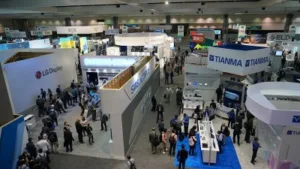SID Display Week is a highlight of the year for me. Apart from the great technology and peek into the future, the event has one of the friendliest press rooms and it’s a great chance to catch up with friends and with our team – we had five people at the event this year looking at different areas. I think we kept duplication and overlap to a minimum, but it’s always a challenge!
It’s always interesting to see who isn’t at these events. Last year, the microLED companies didn’t appear, but several of them attended this time. The one we particularly noted was Sharp, which didn’t have a booth for the first time that I could remember. I heard, unofficially, that since the Foxconn takeover there have been a lot of changes at Camas, where Sharp USA is based and I heard there have been some job losses.
LG Display and Samsung Display both limited what they showed that was really new. Samsung had a stretchable OLED and a very high resolution display for AR/VR, but LG Display had nothing that it hadn’t showed at CES. However, there was lots from those that would like to, and will, challenge these two companies for leadership. BOE had a huge amount to show, as did JDI, AUO and Tianma in the big flat panel display markets. They all had flexible OLEDs, although none of them can make high volume production. There were lots of LCDs for automotive and some great OLEDs for wearables.
 Note the line on the left of the picture into the back of the Samsung booth. It was there from the beginning to the end.
Note the line on the left of the picture into the back of the Samsung booth. It was there from the beginning to the end.
There were lots of different displays for Near to Eye displays – using multiple technologies at very high pixel densities. MicroLED looks as though it will have a clear opportunity for very high brightness to challenge ambient light in AR applications. OLED looks as though it will be the obvious solution for VR headsets where high brightness is not needed.
In automotive, LCD remains the current display and could well keep OLED out for some time. I was impressed with the transparent display that JDI showed that can reach 80% transparency, almost double the level achieved by transparent OLEDs and not that far off from the 90% needed to meet the needs of automotive windscreens.
There was a lot of discussion about QDs. Nanosys has moved on from what it showed at CES, and had a good looking sample of “QD on the filter” technology. It says that products will be on the market next year and we wouldn’t doubt that, based on what was shown. BOE surprised everyone by showing an electro-emissive QD display, based on inkjet processing. At the moment, that looks like a good bet for TV panel technology in 2020 or therabouts, but perhaps BOE wants to see it earlier.
A highlight last year was the ClearInk electrophoretic display and it got a ‘Wow’ from me when I saw the quality of its latest samples, which were running at video rates. There was a big improvement from last year, and we were impressed then. E Ink also pushed things on, with 400 ppi and 600 ppi displays shown in a technology demo with JDI. JDI also had a very, very low power reflective LCD of 32″ that might be good for digital signage.
Light field and aerial displays were also a hot topic and there were a number of samples, with JDI again showing a display that impressed me. I’m used to spotting the dark stripes when looking at AS3D displays from different angles. To move around the JDI display, without these artefacts was a new experience.
Anyway, I hope you enjoy our coverage! Bob
(Sweta Dash was also at the show and contributed her highlights in a Display Daily )

